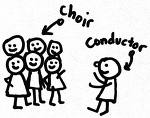Ok, I thought I was the only one who did this…thankfully. I am NOT!
When I was in high school, I was taught that “stagger breathing” was taking a catch-breath in between words. A I grew in my craft, it occurred to me that in a choir situation, this could be ominous: too many repeated consonants, and LOTS of “S” at the end of a word going on…
But how do you fix that? The answer is easy, but difficult to employ at first because it is soooo counter-intuitive! Here it is:
Instead of taking a breath in between words, take your breath instead of a word. You read that right! Instead of singing a short word or note (the word “the”, for example), pretend you are singing it (for the audience’s benefit)…but in reality, you want to inhale instead!
Now, this needs to be practiced; the technique is difficult at first, if one was trained to take that catch-breath in between words. Once each individual in your choir becomes more comfortable with this concept, it’s time to make sure that everybody doesn’t take their breath on the same word!
That’s how I found out I wasn’t the only one who used this technique: an acquaintance of mine, Linda, and I were hired as ringers to be the only two altos at a performance. At rehearsal, I decided to employ “my new technique”…only to discover that Linda was doing the same thing! And yes, we were taking our breaths (for long phrases) on the same words. We kept snickering every time it happened; at the break, we sat down to “divide up” the words so we wouldn’t stagger breathe at the same time.
And I thought I was so clever….! Have any of you been practicing this method?
 I was under a director once, Robert Guenzler, when I was in high school. After spending a good portion of the first few sessions of the school year in practicing good unison singing, he always taught a piece to the choir in this way:
I was under a director once, Robert Guenzler, when I was in high school. After spending a good portion of the first few sessions of the school year in practicing good unison singing, he always taught a piece to the choir in this way: This morning I heard Fred Childs on NPR’s “Performance Today” speak about tempo. He used as an example Beethoven’s “Moonlight Sonata”; he contrasted two renditions: one was a very slow adagio, and the other quite a bit faster, more of an andante performance.
This morning I heard Fred Childs on NPR’s “Performance Today” speak about tempo. He used as an example Beethoven’s “Moonlight Sonata”; he contrasted two renditions: one was a very slow adagio, and the other quite a bit faster, more of an andante performance.
Comments